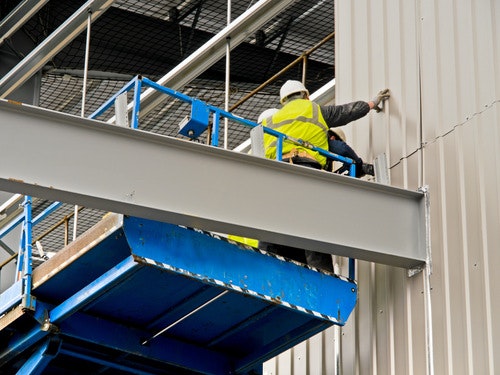Asbestos in the workplace is a huge danger to the health of you and your staff. As an employer, it's your legal duty to manage asbestos exposure at work.
To ensure your team can work safely there are procedures and regulations that need to be followed. Otherwise, you could face tribunal claims, legal costs and reputational damages.
In this guide, we will explore the health risk asbestos poses to employees and what you can do when you encounter it at work.
What is asbestos?
Asbestos is a group of six natural minerals which are resistant to heat and decay. Many buildings and products contain asbestos material because of its fire-protective qualities.
Examples of its use include:
● Asbestos insulation for pipes and floor tiles.
● Fire blankets.
● An asbestos cement roof.
● An asbestos insulating board.
● Wall and ceiling coatings.
What are the health risks associated with asbestos?
Damaging building materials can disturb asbestos and release fibres into the air. If a worker inhales these fibres, it can result in cancer and other causes.
Diseases associated with asbestos include:
● Mesothelioma (a form of cancer).
● Asbestosis.
● Pleural thickening.
Let's examine these risks in more detail.
Mesothelioma
Mesothelioma is a type of cancer which forms in a layer of protective tissue. This tissue covers most of the body's internal organs.
Once inhaled, asbestos fibres become stuck in the soft lining of these organs. As a result, tumours form in the damaged tissue.
Asbestosis
Long-term exposure to asbestos causes Asbestosis - a severe lung disease. It takes many years before symptoms begin to kick in as the damage is gradual.
Symptoms of Asbestosis include:
● Shortness of breath.
● Persistent cough.
● Wheezing.
● Extreme tiredness.
● Chest pain.
Pleural thickening
Exposure to asbestos materials can cause the tissue layer surrounding the lungs - also known as pleura - to harden over time. This is Pleural Thickening.
Chest pain and shortness of breath are the most common symptoms of Pleural Thickening. Ultimately, the condition makes it difficult to breathe.
How likely are you to discover asbestos at work?
Any worker can be exposed to asbestos. Especially since most construction of non-domestic premises in the last century contained such materials.
However, some professions are more likely to encounter asbestos than others.
These include:
● Construction and maintenance workers.
● Engineers.
● Insulators.
Let's explore the UK's law and present asbestos regulations.
UK Control of Asbestos Regulations
According to the UK's Control of Asbestos Regulations, UK sites cannot use, import or manufacture asbestos.
But, non-domestic premises built before 2000, most likely have asbestos containing materials. Non-domestic premises include shops, offices and factories.
In this case, the duty holder or building owner must assess, control and manage asbestos containing materials within the building.
What the law means for employers
Employers operating in non-domestic premises should determine the risk their workers have of exposure to asbestos and follow regulations.
If they are the duty holder, they should take reasonable steps to decide the precautions their workers should follow.
Duty holders are the owners of non-domestic premises. Or even a representative that has official responsibility of the building’s maintenance.
For example, they may:
- Assume building materials contain asbestos until given sufficient evidence otherwise.
- Provide appropriate information, instruction and training to employees about where the identified asbestos is and what condition it's in.
- Consult a health & safety professional to control measures and present a maintenance plan that details how these risks will be managed.
- Carry out medical surveillance of employees to assess whether they need additional requirements.
Identifying asbestos in the workplace
Damage from asbestos doesn't happen overnight - the effects usually take a long time to develop. So, it's important to take precautions to manage and prevent exposure long-term.
If you've identified asbestos containing material in your workplace, you must cease work activities immediately. This is especially important if you work in construction.
You should also:
- Carry out a risk assessment.
- Decide whether you need to hire a licensed contractor.
- Hire a health & safety professional to provide training.
Let's explore these actions in more detail.
Risk assessment
To ensure the health & safety of your workers you should carry out a risk assessment.
Risk assessments should be carried out by someone with sufficient knowledge and expertise of potential exposure to asbestos. For example, a safety representative at your business.
A risk assessment will determine:
● The risk the material containing asbestos poses to you and your staff.
● What action needs to be taken to reduce or remove the risk.
● Who is likely to be affected.
Once the risk assessment has been delivered, you should ensure your action plan is implemented immediately.
For more information on risk assessments and how to perform them, check out our guide.
Licensed work and non-licensed work
If you work in construction, you should take further action to ensure the health of your team.
This includes providing information, instruction and training to workers on how to avoid disturbing asbestos containing materials further. For example, regular record keeping of the asbestos and its condition.
You will also need to determine whether you need a license to continue construction work. This depends on how high the risk of asbestos is.
Work with higher risk asbestos requires a licensed contractor. Specifically, one who is a member of a recognised trade association. For example, the Asbestos Removal Contractors Association.
Contractors doing non-licensed work can still perform the following tasks:
● General cleaning of loose debris containing asbestos in small amounts.
● Drilling of coatings for installation of fixtures/fittings.
● Sealing-in work on material containing asbestos.
Asbestos awareness training
Staff at risk of asbestos exposure must receive adequate training.
Asbestos awareness training offers valuable information on how to avoid damage to asbestos substances. Those unaware of this information can put themselves and others at risk of inhaling asbestos fibres.
How to minimise the risk of asbestos exposure in the workplace
Exposure to asbestos is inevitable in certain professions. But there are a number of ways you can minimise the risk in your workplace.
These include:
- Making sure your workplace has the right ventilation to decrease the amount of asbestos fibres in the air.
- Using the appropriate protective gear and practising good hygiene.
- Limiting a worker's time spent in an exposed area to ensure they aren't working near asbestos more than they have to.
You can minimise the risk of exposure to asbestos by taking precautions when carrying out any work that could disturb asbestos.
If you are suspicious something you’ve encountered may be asbestos, you should stop work and speak to your employer or the building owner. The work may need to be carried out by a licensed contractor.
If you’re planning work where asbestos may be present, get hold of a recent survey or commission one if there isn’t one available. This will show you where the asbestos is in the premises, so you can plan the works to avoid disturbing it.
If you are a licensed contractor removing asbestos, avoid:
- Using methods that create a lot of dust, like using power tools.
- Sweeping up dust and debris - use a Type H vacuum cleaner or wet rags.
- Taking home overalls used for asbestos work.
- Reusing disposable clothing or masks.
- Smoking, eating or drinking in the work area.
Get expert advice from Peninsula
Employers should act quickly when it comes to control of asbestos exposure at work. Having the correct level of Health & Safety training already in place will protect you and your workers from its health risks.
Peninsula offers expert advice and resources for companies about the risk of asbestos exposure. Our HR team provides unlimited 24/7 HR employment services which are available 365 days a year.
Want more information on how to protect your business from employee fraud and all its forms? Seek specialist advice from one of our HR advisors. For further information, call our telephone number 0800 028 2420.



